- From the second century BCE onwards, various rulers established their control over the vast Mauryan Empire: the Shungas, Kanvas, Kushanas and Guptas in the north and parts of central India; the Satavahanas, Ikshavakus, Abhiras, Vatakas in southern and western India.
- The period also marked the rise of the main Brahmanical sects such as the Vaishnavas and Shaivas.
Places where important sculptures are seen
Some of the finest sculptures of this period are found at Vidisha, Barhut (M.P), Bodhgaya (Bihar), Jaggaypetta (Andhra Pradesh), Mathura (UP), Khandagiri-Udayagiri (Odisha), Bhaja near Pune (Maharashtra).
Barhut
- Barhut sculptures are tall like the images of Yaksha and Yakshini in the Mauryan period.
- Modelling of the sculpture volume is in low relief maintaining linearity.
- Relief panels are depicted by narratives and clarity in the narratives are enhanced by selecting main events.
- Narrative panels are shown with fewer characters, but as the time progress, apart from the main character in the story, others have also started appearing in the picture space.
- Availability of space is utilized to the maximum by the sculptors.
- Narrative reliefs at Barhut show how artisans used the pictorial language very effectively to communicate stories.
- One such narrative shows Queen Mahamaya/Mayadevi’s (mother of Siddhartha Gautama) dream.
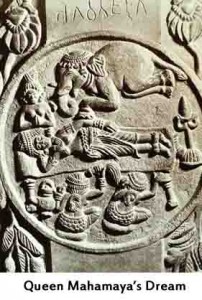
- The queen is reclining on the bed, whereas an elephant is shown on the top heading towards the womb of the queen Mayadevi.
- On the other hand, the depiction of a Jataka story is very simple – narrated by clubbing the events according to the geographical location of the story like the depiction of Ruru Jataka where the Bodhisattva deer rescuing a man on his back.
- Such Jataka stories became part of stupa decoration.
- With the rise in the construction of stupas in various parts of the country, regional stylistic variations also began to emerge.
Sanchi
- The next phase of cultural development at Sanchi stupa-1, Mathura and Vengi in Andhra Pradesh is noteworthy in the stylistic progression.
- Stupa-1 at Sanchi has upper as well as lower pradakshinaptha or circumambulatory path.
- It has four beautifully decorated Torans (Gateways) depicting various events from the life of Buddha and Jataka stories.
- Figure compositions are high in relief, filling up the entire space.
- The depiction of posture gets naturalistic and there is no stiffness in the body.
- The narration gets elaborated and carving techniques appear more advanced than Barhut.
- Symbols continued to be representing Buddhas or past Buddhas (according to the textual tradition there are 24 Buddhas, but only first one, Dipankar, and the last six are pictorially represented).
- Even though narrative gets more elaborated, the depiction of the dream episodes remains very simple (the dream of queen Mayadevi).
STUPA-1, SANCHI (MADHYA PRADESH):
- Sanchi near Bhopal, Madhya Pradesh, is a World Heritage Site.
- Along with other relatively small stupas, there are three main stupas.
- Stupa-1 is presumed to have the relics of the Buddha.
- Stupa-2, the relics of ten less famous Arhats belonging to three different generations (In Theravada Buddhism, an Arhat is a perfected person who has attained Nirvana. In other Buddhist traditions, the term is used for people far advanced along the path of Enlightenment, but who may not reach full Buddhishood).
- Stupa-3 has the relics of Sariputta and Mahamoggallana/Mahamougalayana (disciples of Gautama Buddha).
- Stupa-1 is the finest example of stupa architecture and is known for the carvings on its gateways (torans).
- Originally it was a small brick structure which expanded over a period and was covered with stone, vedika (fence) and the torans.
- There is also the upper pradakshinapatha which is unique to this site (i.e., totally two pradakshinapathas).
- The four gateways are decorated profusely with sculptures.
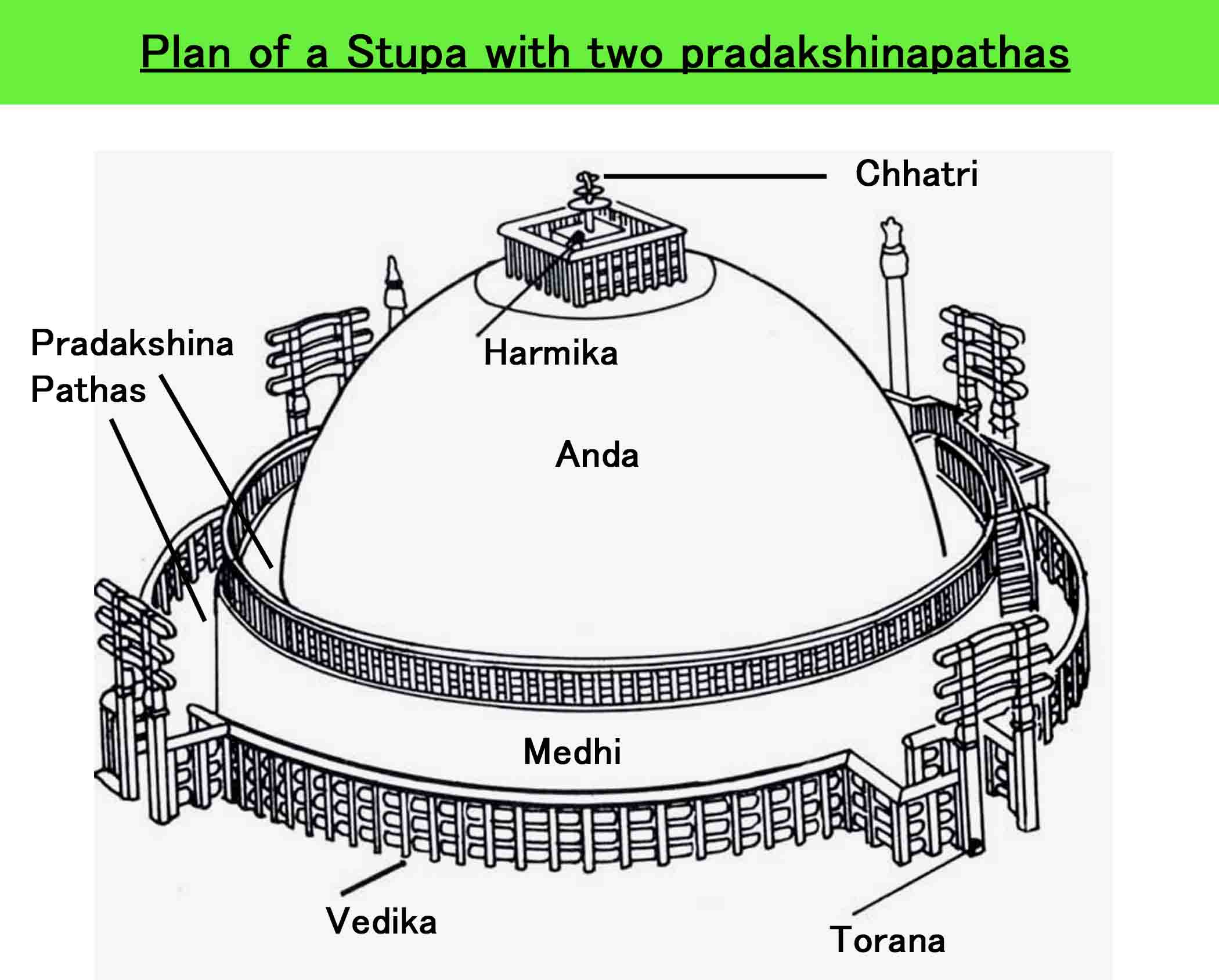
- Buddha is shown symbolically as an empty throne, feet, chhatra, stupas etc.
- Torans are constructed in all four directions.
- Their stylistic differences indicate their possible chronology from the first century BCE onwards.
- Though stupa-1 is the oldest stupa, the carvings of images at the vedika of stupa-2 are earlier than those on stupa-1.
- Jataka stories also became an important part of the narratives.
- The figures in Sanchi despite being small in dimension are very naturalistic.
- There are guardian images on sculptors and salabhanjika sculptures are remarkable in their volume (salabhanjika are sculpture of ladies holding the branch of a tree/plate etc).
- Each torana consists of two vertical pillars and three horizontal bars on the top.
- Each horizontal bar is decorated with different sculptural themes on both sides.
- Supporting the extension of the lowermost horizontal bar from below are the images of salabhanjikas.
Mathura, Sarnath, Amaravati and Gandhara Schools
- In the first century CE onwards, Gandhara (now in Pakistan), Mathura in UP and Vengi in Andhra Pradesh emerged as important centres of art.
- Buddha in the symbolic form got a human form in Mathura and Gandhara.
- The sculptural tradition in Gandhara had the confluence of Bactria, Parthia (both were Indo-Greeks) and the local Gandhara tradition.
- The local sculptural tradition of Mathura became so strong that the tradition spread to other parts of northern India. The best example is the stupa sculpture found at Sanghol in the Punjab.
- The Buddha image at Mathura is modelled on the lines of earlier Yaksha images, whereas in Gandhara it has Hellenistic features. [Hellenistic art is the art of the Classical period dating from the death of Alexander the Great in 323 BCE to the emergence of ancient Rome].
- Images of Vaishnava and Shaiva faiths are also found at Mathura, but Buddhist images are found in large numbers.
- The images of Vishnu and Shiva are represented with their Ayudhas (weapons).
- Characteristics of the different architectural schools are explained below with a suitable example from each.
Seated Buddha, Katra mount, Mathura:
- A large number of images dating back to the Kushan period are from Mathura.
- The image of Buddha from Karta Mount belongs to the second century CE.
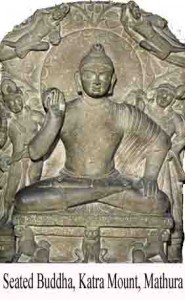
- It represents the Buddha with two Boddhisattva attendants.
- The Buddha is seated in Padmasana and the right hand is in the Abhayamudra.
- The face of the Buddha is round with fleshy cheeks.
- The Ushanisha (hair knot) is shown with a vertical raised projection.
- Mathura sculptures from this period are made with light volume having a fleshy body.
- The sanghati (garment) covers only one shoulder.
- The attendant figures are identified as the images of Padmapani and Vajrapani Bodhisattvas as one hold lotus and the other a Vajra (Thunderbolt).
- The halo around the head of Buddha is very large and is decorated with simple geometric motifs.
- There are two flying figures placed diagonally above the halo.
Seated Buddha at Sarnath, UP:
- The image of Buddha from Sarnath made of chunar sandstone belongs to the late fifth century CE.
- The Buddha is shown seated on a throne in Padmasana.
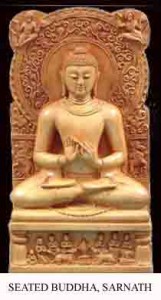 It represents Dhammachakrapravartana (first sermon) as can be seen from the figures on the throne.
It represents Dhammachakrapravartana (first sermon) as can be seen from the figures on the throne.- The panel below the throne depicts a Chakra (wheel) in the centre and a deer on either side with his disciples.
- Thus, it is the representation of the historic event of Dhammachakrapravartana or the preaching of dhamma.
- It is the finest example of Sarnath School of sculpture.
- The face is round, the eyes are half closed, the lower lip is protruding, and the roundness of cheeks has reduced as compared to the earlier images from the Kushana period at Mathura.
- The hands are shown in Dhammachakrapravartana Mudra.
- The Ushanisha has circular curled hairs.
- The aim of the sculptures in ancient India had always been to represent the Buddha as a great human being who achieved Nibbana (cessation of anger and hate).
Buddha Head, Taxila, Gandhara:
- The Buddha head from Taxila in the Gandhara region, now in Pakistan, dates back to the second century CE and belongs to the Kushanas period.
- It shows the hybridized pictorial convention that developed during the Gandhara period.
- It has Greeko-Roman elements.
- The Buddha Head has typical Hellenistic elements.
- The curly hair of Buddha is thick having a covered layer of shape and linear strokes over the head.
- The forehead plane is large having protruding eyeballs, eyes are half closed and the face and cheeks are NOT round like the images of other parts of India.
- There is a certain amount of heaviness in the figures of Gandhara region.
- The ears are elongated, especially the ear lobes.
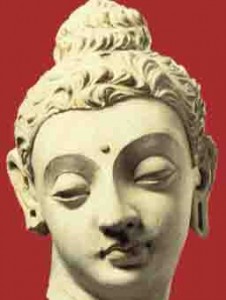
- The treatment of the form bears linearity and the outlines are sharp.
- The surface is smooth and the image is very expressive.
- The expression of calmness is the centre point of attraction.
- Modelling of face enhances the naturalism and three-dimensionality.
- Assimilating various traits of Acamenian, Parthian and Bactrian tradition into the local tradition is a hallmark of Gandhara style.
- The source of development of Buddha images as well as other has its genesis in its peculiar geopolitical conditions.
- It may also be observed that the north-western part of India, which is now in Pakistan, always had continuous habitation from proto-historic times. It continued in the historic period as well.
Amaravati stupa, Andhra Pradesh:
- Vengi in Andhra Pradesh has many stupas like Jagayyapetta, Amaravati, Bahattiprolu, Nagarjunakonda, etc.
- Amaravati has a Mahachaitya and had many sculptures.
- Like Sanchi stupa, Amaravati stupa also has pradakshinapatha enclosed within a vedika on which many narrative sculptures are depicted.
- The domical stupa structure is covered with relief stupa sculpture slab which is a unique feature.
- The torana of the Amaravati stupa has disappeared over a period of time.
- Like Sanchi, the early phase is devoid of Buddha images but during the later phase (2nd and 3rd CE); the Buddha images are carved on the drum slabs and at many other places.
- The sculptural form in this area is characterized by intense emotions.
- Bodies are shown with three bends (Tribanga), and the sculpture composition is more complex than Sanchi.
- The Dream of Queen Mayadevi has also been depicted here.
- Independent Buddha images are also found at Amaravati, Nagarjunakonda and Guntapalle.
- Guntapalle is a rock cut cave near Eluru, Andhra Pradesh.
- In Karnataka, Sannati is the largest stupa excavated yet.
- Along with the images of Buddha, other Buddhist images of Bodisattvas like Avalokiteswara, Padmapani, Vajrapani, Amitabha, and Maitreya Buddha started getting sculpted.
| Gandhara | Mathura | Amaravati |
|
|
|
Comments
Post a Comment